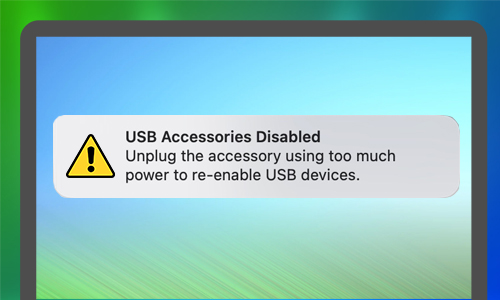How to fix the USB Accessories Disabled error on Mac? Is your dependable Mac having temper tantrums? You are not, however, alone. Disabling USB accessories is a fairly common error with Macs that are connected to multiple peripherals. To continue using USB ports on your Mac, you must resolve this error. Continue reading to learn how to resolve the USB Accessories Disabled error on Mac.
Are you bothered by a USB device or USB accessory being disabled when connecting a USB device to your Mac PC? If so, you can read this article to learn why this problem arises and how to resolve it. Tenorshare 4DDiG Data Recovery Software also explains how to recover data from a USB drive.
Table of Contents
How to fix the USB Accessories Disabled error on Mac?

Here is the list of 8 methods to fix the USB Accessories Disabled error on Mac:
Method #1. Check USB ports and cables
Lint and other debris tend to accumulate in USB ports over time. When this happens, devices connected to the port fail or are not detected. Fortunately, cleaning ports is simple. Take a cotton earbud with you. Dip it in isopropyl alcohol or hand sanitizer to clean it. Gently wipe the insides of the ports. Take care not to damage the connectors.
Faulty cables could also be the source of the problem. Examine the cables for damage, particularly at the ends. If the cable has reached the end of its useful life, consider replacing it.
Method #2. Reconnect USB ports
Sometimes faulty accessories are to blame. Disconnect and reconnect all USB accessories. If the problem persists, remove the accessories separately. Determine which device(s) is causing the problem. Check for errors after disconnecting the faulty device.
Each USB-connected device consumes a specific amount of power. Some accessories, however, require more power than others. Check for errors after disconnecting such devices.
Method #3. Try a different port to fix the USB Accessories Disabled error on Mac
Even after cleaning the ports, you’re still getting the USB Accessories Disabled error. The port is almost certainly damaged. Connect the device to a different USB port and see if that helps. If everything is fine, have the port checked.
I’ve had problems when using USB 3.0 devices with USB 2.0 ports. It is mostly caused by a faulty power supply. Always check the USB specifications of the device and make sure they are compatible with your Mac. Most USB 3.0 devices are backwards compatible. However, even they may face power struggles.
Method #4. Use a powered Thunderbolt 3 or USB-C hub
The USB hub is an excellent way to expand the number of ports on your Mac. USB-Hubs are notorious power hogs. It is always preferable to buy a USB hub with an external power supply. You can resolve the USB Accessories Disabled problem by using a USB hub with an external power supply.
Method #5. Reboot your Mac and install the latest software.
It is always a good idea to restart your Mac from time to time. A reboot clears temporary memory and corrects minor software errors. Inadequate power management at the operating system level can sometimes disable USB accessories. A reboot will quickly resolve this problem.
We must now eliminate the possibility of a software bug. Upgrade macOS to the most recent version. Here’s how to do it:
Tap the Apple logo, then select System Preferences, Software Upgrade, and Upgrade Now.
Method #6. Reset SMC to fix the USB Accessories Disabled error on Mac
The System Management Controller is a physical unit that manages critical components of the Mac. It is in charge of the battery’s normal operation, USB accessories, power, and thermal management. It is possible that resetting SMC will resolve the USB Accessories Disabled issue.
Method #7. Reset PRAM and NVRAM (for Intel based PC)
PRAM is an abbreviation for Parameter Random Access Memory, and NVRAM is an abbreviation for Non-Volatile Random Access Memory. The modules store data about the startup disc, screen resolution, time zone, and so on. This step is not for you if you own a Mac with Apple Silicon.
Method #8. Apple Support
The problem could be caused by faulty hardware. Perhaps the power supply for the USB port has failed. In the worst-case scenario, a USB port on the motherboard fails. If nothing else works, contact Apple Support. Consider taking your Mac to an Apple or Apple-certified service centre near you. The repairs will be covered by the manufacturer’s warranty.




